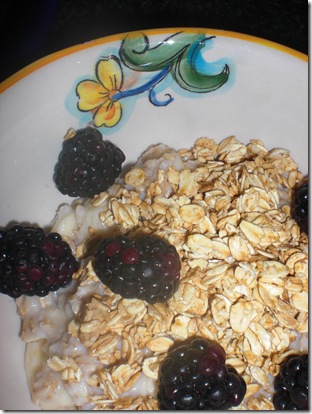Do you ever wake up and then immediately start scheming of ways to go back to sleep? You know… "if I skip my shower, I can sleep 10 more minutes" or "if I eat cereal instead of oatmeal, I can sleep for 5 more minutes." Bargaining with myself never works, so I just pushed myself out of bed and stumbled to the crack — err coffee — pot.
Breakfast was really delish (and worth the extra 5 minutes):
My oatmeal contained:
- 1/2 cup oatmeal
- 1/2 cup milk
- 1/2 cup water
- 1 sliced banana
- Toppings: granola and blackberries
Understanding the Puzzle of Speedwork, From Runner’s Lounge
I wanted to share this great post from Runner’s Lounge.
What is a "Repeat" in Speedwork And Why Is It Important?
Repeats are not intervals. When we do intervals, the term ‘interval” actually refers to the time spent recovering.
Repeats are generally shorter distances, e.g., 200 meters, 400s, 600s that we run at faster speeds that we can repeat several times in a workout. Repeats improve the speed, efficiency and fluidness of our leg turnover. Repeats don’t improve our ability to run sustained speed; those improvements come with interval and threshold training. We run repeats to become familiar and comfortable with a higher intensity of running.
The key to repeats is being able to “repeat” the distance with the same quality at the end as at the beginning of the workout. For example, if you’re running repeat 8 x 400s, the goal should be to hit the same finish time pace for each 400. However, if you’re trying to run each repeat a little faster each time and get a scorching PR on that last 400 to brag about, then you’re not doing repeats and you’re missing the maximum benefit of the workout.
To do a repeat workout well means managing the recovery time. Rather than limit your recovery to a specific amount of time for recovery (that’s running intervals), you manage a repeat workout subjectively giving yourself enough recovery to hit your time goal without hitting the fatigue that slows you down.
A general guideline when running repeats is to take two to four times the duration of your repeat to recover. Between the first several repeat 400s you might need around three minutes to adequately recover. But between the last several repeat 400s, you might need closer to four minutes. That’s okay because the goal is to run each 400 at a comparable stress level, not faster.
Simply, we should take enough recovery time to be ready to run each distance with the same quality as the first—so you can repeat the intensity and quality of the running! We should step up to the line feeling confident we’re able to perform the next run as well as the ones before it. That’s what makes it a repeat!
The downside to running repeat speed workouts is we can become a little tight and stiff while recovering. Plus the overall time for our running workout takes longer to perform.
The great thing about repeat workouts is you can create lots of different combinations. I like 200s, 300s and 600s, but I don’t care for 400s—flashbacks of my high school track workouts. A favorite workout of mine is 3 x 200 + 1 x 300, and do a couple sets of these. You can also do longer repeats such as 800s, 1000s and 1200s, when they fit into the race distance for which you’re training.
A rule of thumb is to limit repeat training to about 5% of total weekly mileage. Any more than 5%, plus any other quality speed training, leads to diminishing the quality of running the rest of the week, to overtraining, and to the likeliness of injury.
Repeat training is often included more in training for 5k – 10k races. In terms of placement in the training program, repeats generally come before interval training in order to help the body adapt to running faster with full recovery before adapting to limited recovery.
Happy running!



This morning I woke up an hour early. I wasn’t bargaining with myself, I was just trying to see if I could get back to sleep…at least I have plenty of time for all of the things you mentioned: cooked breakfast, working out, etc. Sigh.